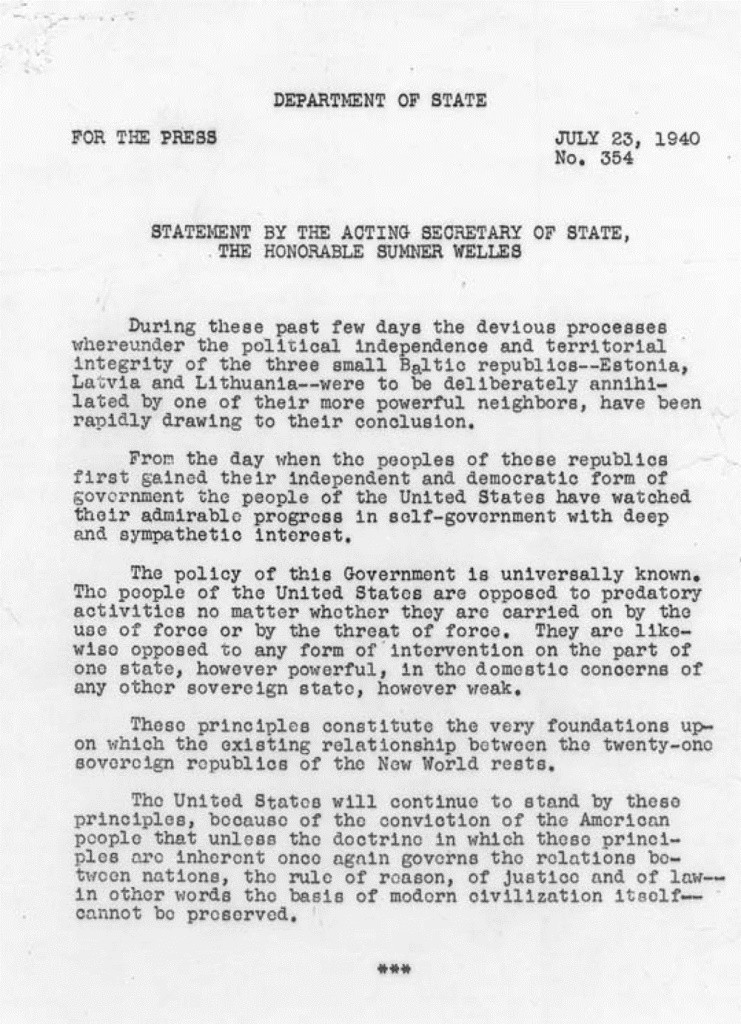Eighty-five years ago, a bold US statement rejected the Soviet occupation of Estonia and its Baltic neighbours; it became the foundation of Western non-recognition and helped Estonia reclaim its independence in 1991.
On 23 July 1940, a senior American diplomat stood against the tide of history. Acting US Secretary of State Sumner Welles issued a short but firm declaration: the United States would not recognise the Soviet Union’s annexation of Estonia, Latvia, and Lithuania. The Soviet invasion – executed just weeks earlier under the secret clauses of the Molotov-Ribbentrop Pact – was, in Welles’ words, illegitimate. It would remain so in the eyes of the United States for the next 51 years.
Approval by Roosevelt
Though Estonia vanished from the world map during the Cold War, the Welles Declaration ensured it remained legally alive.
The timing was extraordinary. In June 1940, 30,000 Soviet troops occupied the Baltic states, installing puppet regimes that soon petitioned Moscow for incorporation into the USSR. While most of the world looked away – focused on Hitler’s advance across Europe – the US State Department took a stand.
President Franklin D. Roosevelt personally approved the public rebuke. The first draft came from diplomat Loy W. Henderson, who had personal ties to the region. But Welles, unsatisfied with the language, called Roosevelt directly. Together they reworked the text to deliver a sharper, more forceful condemnation. The final version stated that the United States refused to acknowledge “any territorial change effected by force.”

This declaration was telegraphed to the American embassy in Moscow and broadcast globally. Though the US was not in a position to counter the Soviet Union militarily, it had drawn a clear legal and moral line. As the New York Times put it in 1940, the Welles Declaration was “one of the most exceptional diplomatic documents issued by the Department of State in many years.”
More than words
For the Baltic peoples, it was more than words. The policy of non-recognition enabled Estonia, Latvia, and Lithuania to maintain diplomatic missions in the West throughout the Cold War. Their national bank assets were preserved. Refugees who fled Soviet rule were not repatriated. Most importantly, the legal continuity affirmed by the US helped pave the way for their restoration of independence in 1991.
Successive American presidents reinforced this policy. In 1957, Dwight D. Eisenhower reaffirmed the Baltics’ right to independence. In 1983, Ronald Reagan publicly restated US recognition of Estonia, Latvia, and Lithuania – just eight years before the Soviet Union collapsed.
Even in maps and official US publications, Estonia was never “Soviet Estonia.” The fine print always made it clear: this occupation was never accepted.

Marking the 85th anniversary of the Welles Declaration, Estonia’s foreign minister, Margus Tsahkna, noted that it “contributed to affirming Estonia’s legal continuity” and preserved international awareness through decades of occupation. He added that just as the US rejected the Soviet annexation of the Baltic states in 1940, Estonia today stands firmly behind Ukraine’s right to restore its territorial integrity.
The Welles Declaration reminds us that moral clarity can outlast tanks. It offers a lesson that resonates still: even small nations can endure, when the world refuses to forget them.

